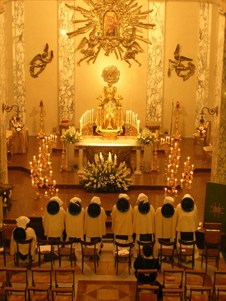The Forty Hours’ devotion
 In the catholic liturgy the Forty Hours’ devotion is the evocation of the period between Good Friday (Jesus’ death) and his resurrection (Easter Sunday). In the Bible, the number 40 is often used as a symbol to indicate a chronological period of testing and isolation. There are two types of celebrations of the Forty Hours: an annual round of uninterrupted adoration that is perpetuated from church to church and a sporadic form, linked only to certain times of the year, often done without nocturnal adoration, which is the most widespread and still in use today in many parish communities. In the seventeenth and eighteenth centuries this second form was introduced in the three days preceding Ash Wednesday as a reparation against the excesses of Carnival, sustained and widespread especially by the Jesuits. The origin of this devotion which carries the title of Oratio Quadraginta Horarum is uncertain. The first evidence of this practice is found among the Battuti of Zara at the church of S. Silvestro, even before 1214, where also the brotherhood In coena domini of the Forty Hours was created. The practice of placing the Blessed Sacrament for the adoration of the faithful for forty hours continuously in order to propitiate the Lord’s intervention, especially in times of calamities and wars, took place for the first time in 1527 at the Church of the Holy Sepulchre in Milan. It was on the initiative of the augustinian Antonio Bellotto from Ravenna (+ 1528) that was also established the school of the Holy Sepulchre for the same purpose, initiating the practice of repeating the Forty Hours even not during the Holy Week. Pope Paul III, by the request of the general vicar of Milan made on behalf of the governor and the people of Milan, approved this practice with papal brief of August 28, 1537. The celebration was institutionalized by Pope Clement VIII in the document Graves et diuturnae in 1592 (Instructio Clementina). Urban VIII, with the encyclical Aeternus rerum Conditor of 6 August 1623, commanded all the churches of the world the celebration of the Forty Hours.
In the catholic liturgy the Forty Hours’ devotion is the evocation of the period between Good Friday (Jesus’ death) and his resurrection (Easter Sunday). In the Bible, the number 40 is often used as a symbol to indicate a chronological period of testing and isolation. There are two types of celebrations of the Forty Hours: an annual round of uninterrupted adoration that is perpetuated from church to church and a sporadic form, linked only to certain times of the year, often done without nocturnal adoration, which is the most widespread and still in use today in many parish communities. In the seventeenth and eighteenth centuries this second form was introduced in the three days preceding Ash Wednesday as a reparation against the excesses of Carnival, sustained and widespread especially by the Jesuits. The origin of this devotion which carries the title of Oratio Quadraginta Horarum is uncertain. The first evidence of this practice is found among the Battuti of Zara at the church of S. Silvestro, even before 1214, where also the brotherhood In coena domini of the Forty Hours was created. The practice of placing the Blessed Sacrament for the adoration of the faithful for forty hours continuously in order to propitiate the Lord’s intervention, especially in times of calamities and wars, took place for the first time in 1527 at the Church of the Holy Sepulchre in Milan. It was on the initiative of the augustinian Antonio Bellotto from Ravenna (+ 1528) that was also established the school of the Holy Sepulchre for the same purpose, initiating the practice of repeating the Forty Hours even not during the Holy Week. Pope Paul III, by the request of the general vicar of Milan made on behalf of the governor and the people of Milan, approved this practice with papal brief of August 28, 1537. The celebration was institutionalized by Pope Clement VIII in the document Graves et diuturnae in 1592 (Instructio Clementina). Urban VIII, with the encyclical Aeternus rerum Conditor of 6 August 1623, commanded all the churches of the world the celebration of the Forty Hours.
In Naples, the practice of the Forty Hours is reflected in various churches and in particular at the Oratory of the Girolamini, especially during the last days of Carnival with the specific intent to distract the faithful from the licentious carnival practices. Among other things, already before 1550 the prolonged exposure of the Blessed Sacrament had been strongly desired by San Filippo Neri for the Confraternity of the SS. Trinità dei Pellegrini in Rome. This devotion was introduced and promoted by Giovanni Giovenale Ancina (Fossano, 1545 – Saluzzo 1604) who formulated the instructions drawn up so that the ceremonies were held with solemnity and decorum. At the Neapolitan Oratory, the music written for this liturgy by the priest and musician Erasmo di Bartolo (Gaeta, 1606 – Naples 1656) also called Padre Raimo, was famous. In particular, his motets for four choirs are significant, which continued to be copied and executed during the Spanish government and the subsequent Austrian rule until the end of the eighteenth century. On 15 February 1662 the viceroy Gaspar de BracamonteGaspar de Bracamonte y Guzmán, third Count of Peñaranda (1595-1676), came from one of the oldest and most powerful aristocratic families in Spain. He was Chairman of the Council of the Indies, the head of the Spanish delegation to the Peace of Westphalia in 1648, the viceroy of Naples from 1659 to 1664 and, after the death of King Philip IV (1665), a member of the board of regents who supported the queen widow Mariana of Austria (1634-1696) during the minority of Charles II (1661-1700). attended, during the celebration of the Forty Hours, the execution of the music for 4 choirs of Padre Raimo at the church of the Girolamini.
